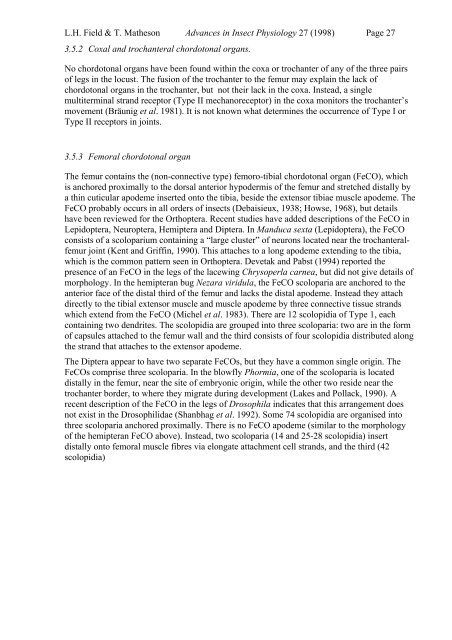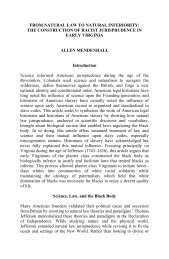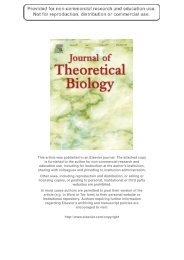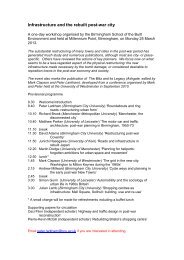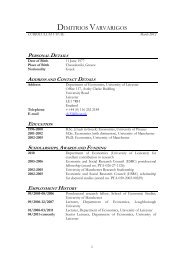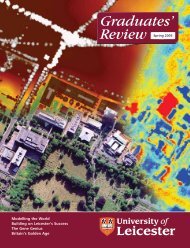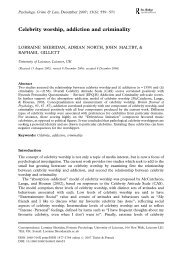Chordotonal Organs of Insects
Chordotonal Organs of Insects
Chordotonal Organs of Insects
Create successful ePaper yourself
Turn your PDF publications into a flip-book with our unique Google optimized e-Paper software.
L.H. Field & T. Matheson Advances in Insect Physiology 27 (1998) Page 273.5.2 Coxal and trochanteral chordotonal organs.No chordotonal organs have been found within the coxa or trochanter <strong>of</strong> any <strong>of</strong> the three pairs<strong>of</strong> legs in the locust. The fusion <strong>of</strong> the trochanter to the femur may explain the lack <strong>of</strong>chordotonal organs in the trochanter, but not their lack in the coxa. Instead, a singlemultiterminal strand receptor (Type II mechanoreceptor) in the coxa monitors the trochanter’smovement (Bräunig et al. 1981). It is not known what determines the occurrence <strong>of</strong> Type I orType II receptors in joints.3.5.3 Femoral chordotonal organThe femur contains the (non-connective type) femoro-tibial chordotonal organ (FeCO), whichis anchored proximally to the dorsal anterior hypodermis <strong>of</strong> the femur and stretched distally bya thin cuticular apodeme inserted onto the tibia, beside the extensor tibiae muscle apodeme. TheFeCO probably occurs in all orders <strong>of</strong> insects (Debaisieux, 1938; Howse, 1968), but detailshave been reviewed for the Orthoptera. Recent studies have added descriptions <strong>of</strong> the FeCO inLepidoptera, Neuroptera, Hemiptera and Diptera. In Manduca sexta (Lepidoptera), the FeCOconsists <strong>of</strong> a scoloparium containing a “large cluster” <strong>of</strong> neurons located near the trochanteralfemurjoint (Kent and Griffin, 1990). This attaches to a long apodeme extending to the tibia,which is the common pattern seen in Orthoptera. Devetak and Pabst (1994) reported thepresence <strong>of</strong> an FeCO in the legs <strong>of</strong> the lacewing Chrysoperla carnea, but did not give details <strong>of</strong>morphology. In the hemipteran bug Nezara viridula, the FeCO scoloparia are anchored to theanterior face <strong>of</strong> the distal third <strong>of</strong> the femur and lacks the distal apodeme. Instead they attachdirectly to the tibial extensor muscle and muscle apodeme by three connective tissue strandswhich extend from the FeCO (Michel et al. 1983). There are 12 scolopidia <strong>of</strong> Type 1, eachcontaining two dendrites. The scolopidia are grouped into three scoloparia: two are in the form<strong>of</strong> capsules attached to the femur wall and the third consists <strong>of</strong> four scolopidia distributed alongthe strand that attaches to the extensor apodeme.The Diptera appear to have two separate FeCOs, but they have a common single origin. TheFeCOs comprise three scoloparia. In the blowfly Phormia, one <strong>of</strong> the scoloparia is locateddistally in the femur, near the site <strong>of</strong> embryonic origin, while the other two reside near thetrochanter border, to where they migrate during development (Lakes and Pollack, 1990). Arecent description <strong>of</strong> the FeCO in the legs <strong>of</strong> Drosophila indicates that this arrangement doesnot exist in the Drosophilidae (Shanbhag et al. 1992). Some 74 scolopidia are organised intothree scoloparia anchored proximally. There is no FeCO apodeme (similar to the morphology<strong>of</strong> the hemipteran FeCO above). Instead, two scoloparia (14 and 25-28 scolopidia) insertdistally onto femoral muscle fibres via elongate attachment cell strands, and the third (42scolopidia)


